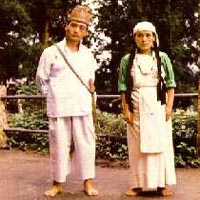| Destinations
|
|||||||||||||||
Ancient and Medieval The Bhutias began entering this region from Tibet during the 14th century. Tibetan migrants who were followers of the sect of 'Red Hats' tried to convert the Sikkimese "Worshippers of nature" to Buddhism. They succeeded to some extent, though the Lepchas tried to keep themselves aloof as far as possible. When the kingdom of Sikkim was established in 1642, Phuntsog Namgyal, the first Chogyal (temporal and spiritual king), came from this community. The Bhutia traced his ancestry from a legendary prince, who founded the Kingdom of Minvang in eastern Tibet in 9th century A.D. |
More about Sikkim • An Overview • Geography • People & Culture • Economy • Festivals • Off the Beaten Track • Wild Life • Adventure • Monastery Magic • Gangtok • Tourist Information • Accommodation • Getting There • Climate • FAQ
Travelogues
Trekking
| ||||||||||||||
 Somewhere in the thirteenth century a prince named Guru Tashi of Minyang dynasty in Tibet had a divine vision that he should go south to seek his fortune in "Denzong - the valley of rice". As directed by the divine vision he along with his family, which included five sons, headed in the southern direction. During their wanderings the family came across the Sakhya Kingdom in which a monastery was being built at that time. The workers had not been successful in erecting pillars for the monastery. The elder son of Guru Tashi raised the pillar single handedly and thereby came to be known as "Kheye Bumsa" meaning the superior one among ten thousand heroes. Somewhere in the thirteenth century a prince named Guru Tashi of Minyang dynasty in Tibet had a divine vision that he should go south to seek his fortune in "Denzong - the valley of rice". As directed by the divine vision he along with his family, which included five sons, headed in the southern direction. During their wanderings the family came across the Sakhya Kingdom in which a monastery was being built at that time. The workers had not been successful in erecting pillars for the monastery. The elder son of Guru Tashi raised the pillar single handedly and thereby came to be known as "Kheye Bumsa" meaning the superior one among ten thousand heroes.
The Sakhya King offered his daughter in marriage to Khye Bumsa. Guru Tashi subsequently died and Khye Bumsa settled in Chumbi Valley. It was here that he established contact with the Lepcha chieftain Thekong Tek in Gangtok. Khye Bumsa, being issueless, went to Sikkim in the 13th century to seek the blessing of Thekong Tek who was also a religious leader. Khye Bumsa was not only blessed with three sons by the Rong chief but it was prophesied that his successors would be the rulers of Sikkim. Out of gratitude Khye Bumsa visited Thekong Tek a number of times. In due course of time the relationship ultimately culminated in a treaty of brotherhood between the two chieftains at a place called Kabi Longtsok. This treaty brought about new ties of brotherhood between the Lepchas and the Bhutias.
Phuntsok (or Penchu) Namgyal was the next ruler. He was Guru Tenzing's son (great grandson of Guru Tashi) and was born in 1604. Phuntsok Namgyal's crowning was charged with all the vivid fantasy and miraculous phenomenon that is associated with an important occasion. Three venerable lamas are said to have entered Sikkim from three different directions at the same time. They met at Yoksam (meaning three wise men) and debated on the desirability of having a temporal and religious head to rule over pagan Sikkim. Two of the lamas furthered their own claims but the third lama reminded them of the prophecy of Guru Padmasambhava that a man coming from the east, Phuntsok by name would rule Sikkim. Since none of them came from the east it was agreed that the prophesied leader must be sought out. Messengers were sent to seek Phuntsok. Near Gangtok, the desired young man was found and the lamas lost no time in crowning him king. They seated him on a nearby rock slab and sprinkled water on him from the sacred urn. He was given one of Lhatsun Chenpo's names, Namgyal, and the title of Chogyal or religious king. It happened in the year 1642. The Namgyal dynasty ruled over Sikkim as hereditary kings for about 332 years. British Rule- 1757 to 1947: Sikkim fought a series of territorial wars with both Bhutan and Nepal beginning in the mid-18th century. Nepal, the more aggressive of the two, attracted the ire of the Chinese and in the ensuing war, Nepal was defeated. The defeat of Nepal by the Chinese did little to weaken the expansionist designs of the Nepalese. They continued to attack neighbouring British territories as well as Sikkim. British India successfully befriended Sikkim. They felt that by doing so the expanding powers of the Gorkhas would be curtailed. The British also looked forward to establishing a trade link with Tibet and it was felt that the route through Sikkim was the most feasible one. War between Nepal and British India broke out in 1814 and came to an end in 1816 with the defeat of the Nepalis and the subsequent signing of the Treaty of Sugauli. As a direct spin-off, British India signed another treaty with Sikkim in 1817 known as the Treaty of Titalia in which former territories, which the Nepalis captured, were restored to Sikkim.
Independent India After 1947, political parties began to be formed in Sikkim for the first time. Among their aims were the abolition of feudalism, the establishment of a popularly elected government, and accession of Sikkim to India - all demands resisted by the Chogyal and his supporters. In 1950, three years after India attained independence from Britain, a treaty was signed between Chogyal Tashi Namgyal and India that made Sikkim an Indian protectorate with the Chogyal as the monarch. India assumed responsibility for Sikkim's external relations, defence and strategic communications. This was in the face of stiff resistance from local parties like Sikkim State Congress who wanted a democratic set-up and accession of Sikkim to the Union of India. Tashi Namgyal died in 1963 and was succeeded by his son Palden Thondup Namgyal. By the beginning of 1970 there were rumblings in the political rank and file of the State, which demanded the removal of the monarchy and the establishment of a democratic set-up. This finally culminated in wide spread agitation against the Sikkim Durbar in 1973. There was a complete collapse of the administration. The Indian Government tried to bring about a semblance of order in the state by appointing a Chief administrator, Mr. B. S. Das. Further events and elections led to Sikkim becoming transformed from a protectorate to an associate State. Five general elections were held between 1952 and 1974. In the last of these elections, two rival parties merged to form the Sikkim Congress, which swept the polls. The party launched a campaign to obtain greater political liberties and rights that the Chogyal attempted to suppress. With the situation getting out of control, the Chogyal asked the Government of India to take over the administration. India prepared a constitution for Sikkim that was approved by its national assembly in 1974. In a 1975 special referendum, more than 97 percent of the electorate voted for the merger of Sikkim with India. Sikkim became the 22nd state of the Indian Union on May 15, 1975.
Compiled by Romola Butalia
|
|||||||||||||||
Editor: Romola Butalia (c) India Travelogue. All rights reserved. |
|||||||||||||||

 Among the Lepchas, with the death of Thekong Tek, they broke into minor clans. They also gradually turned to Guru Tashi for protection and leadership. Guru Tashi appointed a Lepcha, Sambre as his chief adviser and lieutenant. Guru Tashi's rule marked the absorption of the foreign ruling house into the native soil and also paved a way for a regular monarchy. This way Guru Tashi became the first ruler of Sikkim and was crowned as such. He was followed by Jowo Nagpo, Jowo Apha and Guru Tenzing, who pursued the policy of creating progressively amicable relations with Lepchas.
Among the Lepchas, with the death of Thekong Tek, they broke into minor clans. They also gradually turned to Guru Tashi for protection and leadership. Guru Tashi appointed a Lepcha, Sambre as his chief adviser and lieutenant. Guru Tashi's rule marked the absorption of the foreign ruling house into the native soil and also paved a way for a regular monarchy. This way Guru Tashi became the first ruler of Sikkim and was crowned as such. He was followed by Jowo Nagpo, Jowo Apha and Guru Tenzing, who pursued the policy of creating progressively amicable relations with Lepchas.
 The military defeat of Sikkim culminated in the Anglo-Sikkimese Treaty of 1861. The treaty established Sikkim as a princely state under a British paramount, and the British were given rights of free trade and were allowed to make roads through Sikkim to Tibet. In 1890 an agreement was concluded between the British and the Tibetans that defined the border between Sikkim and Tibet. Tibet also acknowledged the special relationship of British India with the kingdom of Sikkim. A British political officer, Claude White, was subsequently appointed to assist the Chogyal in the administration of Sikkim's domestic and foreign affairs and, in effect, became the virtual ruler of the state.
The military defeat of Sikkim culminated in the Anglo-Sikkimese Treaty of 1861. The treaty established Sikkim as a princely state under a British paramount, and the British were given rights of free trade and were allowed to make roads through Sikkim to Tibet. In 1890 an agreement was concluded between the British and the Tibetans that defined the border between Sikkim and Tibet. Tibet also acknowledged the special relationship of British India with the kingdom of Sikkim. A British political officer, Claude White, was subsequently appointed to assist the Chogyal in the administration of Sikkim's domestic and foreign affairs and, in effect, became the virtual ruler of the state.